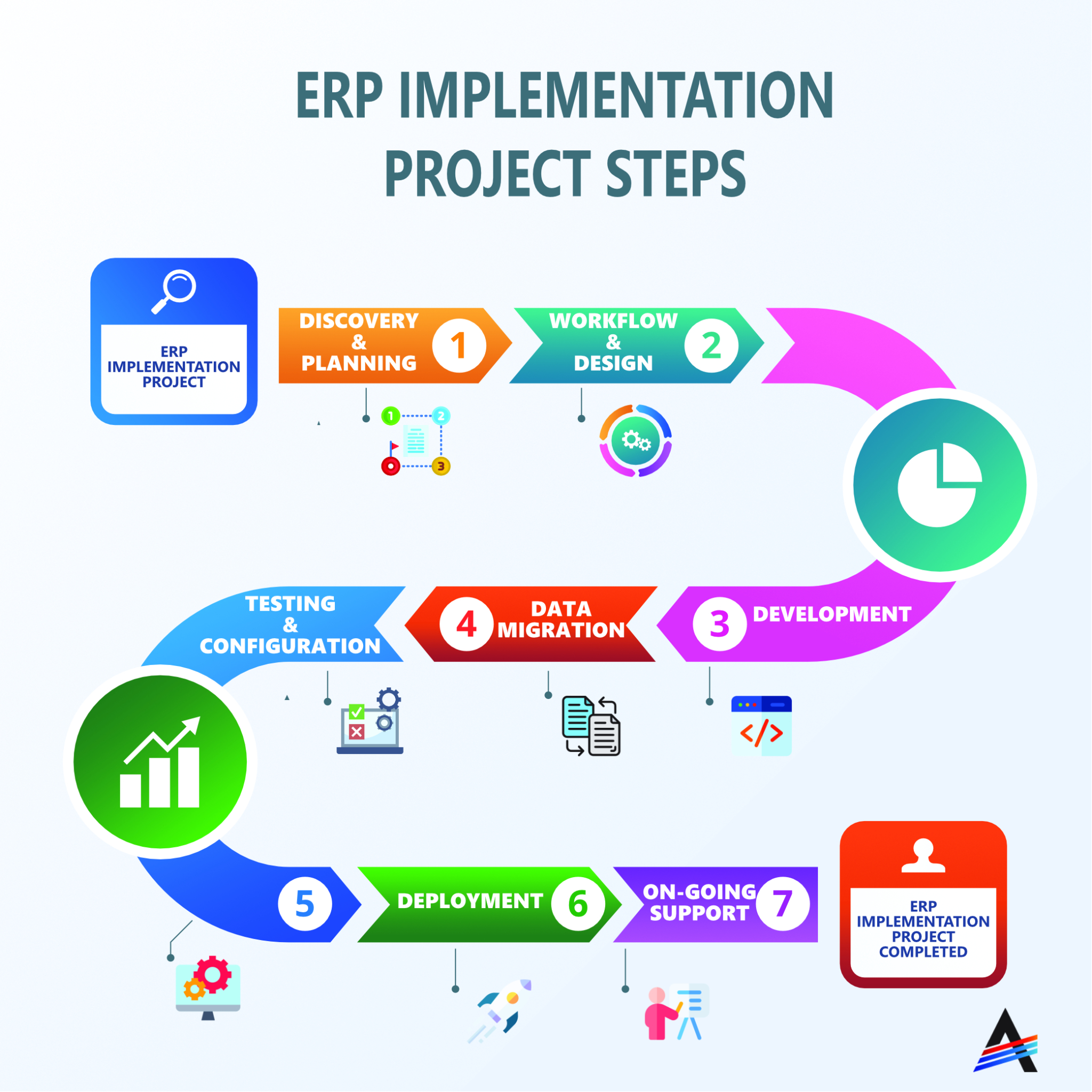What is ERP implementation?
ERP implementation is a process of selecting, planning, testing, and going live with an ERP system in your business and everything in between. It comes with various crucial steps to successfully implement ERP systems to yield the benefits of using ERP systems.
The ERP implementation process starts right from the beginning you have realized that you need to implement an ERP system to achieve the desired benefits.
Many people misunderstand an ERP implementation process as the time when you purchase the software and start implementing it for your business.
However, as you will see, implementing an ERP system comes right from the beginning when you start discovering potential ERP solutions and preparing the scope of requirements for ERP systems.
Having a clear picture of workflows and processes that you want to improve in your business using ERP systems is already part of the ERP implementation process.
With that in mind, let us walk you through the basic 7 step process of implementing an ERP system for your business.
However, before that, I want to say, that every ERP implementation process will differ based on your company requirements, ERP vendor, and the ERP implementation partners. Everybody has their unique way to implement their ERP systems.
For example, Agile Dynamics Solutions has developed a unique ERP implementation methodology and achieved a 100% implementation rate for small to large size organizations in the past 20 years.
7 Steps of ERP Implementation
Step #1: Discovery & Planning
The first step of ERP implementation begins when you are aware of your challenges and you know that an ERP system is a solution that can help solve your problems.
This phase includes researching and selecting the right ERP system, setting up a project team that will be accountable to map all the requirements, challenges you want to solve, and goals you want to achieve.
The project team is often made up of different roles. Typically, it is consistent with personal from higher management, IT department, project manager, and representatives from departments often from Finance, Sales, and Operations, depending on the modules you are implementing and in some cases third-party personal like consultants to help your project team.
The well-built project team is an essential part of your ERP implementation project and taking time to identify the main roles that should be involved in this project will be crucial to a successful implementation of an ERP system.
During this period your project team will develop the documentation as the team works to identify current issues. The project team will prepare a detailed project plan understanding current issues, including processes, workflows, inefficiencies, and requirements for the ERP system.
The well-prepared plan will showcase all the issues within business processes across the departments and showcase the goals the business wants to achieve such as faster financial close, improve reporting, gain deeper business visibility, improve customer service, etc.
These can be used to direct more detailed analysis, including documentation of existing workflows. This preparation will help the project team to identify the right ERP solutions that meet your business needs and requirements.
Step #2: Workflow & Process Design
The workflow and design step works from detailed requirements and an understanding of the current workflow to develop a design for the new ERP system. Here your project team will look deeper into your business processes and analyze their insufficiencies and other costly problems.
Once your team analyses your workflows and other business processes then it’s time to design new, more efficient, and other business processes to implement within the system. It’s important to know the goals of the workflow and what exactly needs to be done to help businesses to do more with less.
It’s also important to include users in the workflow & process design since they are the one who has the understanding of current processes and knows what needs to be done to improve efficiency and productivity. This also helps with the adoption of the new system as users are involved within the ERP implementation process.
Lastly, your team should also look into Gap Analysis to identify missing workflow and processes that your business would benefit from. It’s important to establish a strong foundation for your new system so you can build on it as your business grows.
This helps to select the right ERP vendor and system to have all the needed capabilities for your business to maximize the potential of your new ERP system.
Step #3: Customization & Development
Once your team and business have a solid understanding of your current processes, selected the ERP system and you know where you are heading, the next step is to develop and customize your solution.
This involves the configuration of your ERP system to your business, setting up operating location/s and its taxes, and other requirements, integration with other organizations’ existing systems, industry requirements, and more.
It may also include customization to parts of your ERP system based on your design requirements and installing necessary hardware and/or software based on the type of ERP deployment you choose.
At this point, a large part of the ERP implementation process is in hands of the ERP vendor and its partners and your project team will be overlooking the project. However, the project team should start preparing the training plan and materials to help team members new and current to adjust to the new system.
Step #4: Data Migration
Another essential step of your ERP implementation process is data migration. During the customization and development of your ERP system, your project team should already begin planning the data migration.
This can be a very complicated process and it involves extracting, cleaning, organizing, transforming, and uploading data from multiple systems, each may use different formats and may hold duplicated or inconsistent data, which could be one of the reasons why you are moving to an ERP system.
The project team here should decide which data to migrate in this phase. Here the ERP vendor and/or partner often helps with data migration. However, it is important to know which data you need in the new system and which you don’t need.
Therefore, before converting and migrating all the data into your new ERP system, you should filter out everything that you find unnecessary or incorrect, so the new system is clean and accurate.
Also, this helps reduce the time of data migration resulting in saving on price on the men-day as ERP vendors or partners charge per the time it takes to implement the ERP system.
Step #5: Configuration & Testing
As the development and data migration progresses, another step that may occur concurrently is configuration and & testing.
We have already mentioned during the customization that the ERP system will be configured with your company details, users, location, etc. As the implementation project is progressing, your project team may start testing the first modules to develop fixes or adjustments based on the results and retest them.
This is when you take your detailed design plan agreed with the ERP vendor and test out everything as agreed. Initial testing of the basic features gives users a better understanding of the system and lets users rigorously test the full capabilities of the system for all their day-to-day activities.
This will help to further configure and customize the system to business needs to ensure successful completion of the ERP system. Also, users and the project team should pay close attention to migrated data to ensure nothing is missing or was overlooked.
Of course, at first, there will be friction of using the system before proper training will be established, which can be often conduct by the ERP vendor or its partners. Most ERP vendors provide also self-help portals and libraries for quick fixes and learning.
For example, Microsoft Dynamics 365 provides hundreds of online videos, documentation, university and online courses to learn how to use their systems on your own quickly and efficiently. However, proper training is essential to maximize the use of the system
Step #6: Deployment
One of the final steps and the one everybody is waiting for is the deployment step. This is when your project team and the vendor finally let the system goes live. Definitely, one of the most exciting times to start benefiting from the system.
Now, despite all the preparation and rigorously testing, prepare yourself for hiccups and potential issues coming up. As mentioned, an ERP system is a centralized database for many different parts of your business and there are many different moving parts.
Therefore, some issues may come to the surface only once the system is fully live. Also, while the ERP implementation was in progress, the business was still running and generating more data. This data from before your system went live needs to be migrated to your system as well.
Your project team must be ready to train and provide prepared educational materials as discussed to help users understand and use the system. For some of the users, it may be harder to adapt to the new system, especially if they are used to use their typical legacy software to complete their tasks.
Regardless the system is already live, you should still consider it as a testing trial as now, all the users have final access, and the system is working with live data and is tested in the field. This will give you important information if there is something that needs to be updated or changed.
Step #7: Change Management & On-Going Support
Once the ERP system has gone life it’s time to prepare your users to effectively use the system to maximize its potential. One of the reasons why ERP does not deliver a strong ROI to organizations is because the users were not properly trained to use the system to its fullest.
Therefore, companies should implement proper change management to reduce user friction and help employees to learn how to use the system to complete their day-to-day tasks more efficiently.
Often, once employees feel the benefit of the system and increased productivity, they are a lot more willing to learn using the system on their own. Thus, change management is crucial for companies. ERP system is not a fixed asset like a computer and management needs to understand that not everybody is ready to give up on a good old spreadsheet.
Nurturing the ERP implementation even after the deployment is important to keep users happy and ensure the business achieves higher ROI from the system. The project team still has a lot of work to do, as more issues might get uncovered, more training needs to be provided and user feedback is important to further configure the system or customize it if needed.
That same applies to new staff to help them onboard and use the system. Therefore, the project team still should be developing training materials and updating the old ones.
And of course, if any issues appear with the system you need to communicate with the vendor to fix them as soon as possible to achieve minimum disruptions.
4 Reasons Why ERP Implementation Fails?
Failure #1: Lack of Commitment by Stakeholders
As you can see, an ERP implementation project is very complicated and complex and it requires many people to cooperate including key stakeholders across different departments. However often due to the lack of commitment from stakeholders such as not investing enough time into different parts of the ERP implementation can cause the ERP implementation to fail.
Likewise with investing enough resources. In many cases, ERP projects can go over budget or requires more resources to complete the ERP implementation. However top executives may be unwilling to locate resources for the project.
With that, ERP implementation is a big project for any company and you should prepare yourself that complications might occur that require more resources from you. However, an ERP system is a great investment and it can yield massive ROI for your company.
Failure #2: Poor project management
As explained, ERP implementation comes with a lot of planning and preparation that needs to be done by your company. Nobody knows better your company, the processes, and workflows than your employees.
So whether you take ERP consultants to help you with the implementation process or not, you need to create a project team of highly skillful and competent employees that know your business, processes, workflows, and ineffectiveness within your business.
It takes good leadership and collaboration to keep things on track and to hold people accountable. However, it is also recommended to hire consultants or someone with experience in ERP implementation management to help you get through successfully.
Failure #3: Lack of Planning
One of the biggest reasons why ERP implementation project fails is due to lack of planning and it’s not difficult to see why.
A major issue with implementing any hardware or software is procuring the necessary resources – hardware and software – along with the appropriate network architecture, custom development tools, and skilled staff.
As mentioned, when delivering an ERP system for your organization you must go through vigorous planning, designing, testing, selecting, and more to successfully implement an ERP system. ERP implementation failure generally results from inadequate planning and resource management, coupled with a lack of awareness regarding risks.
This failure can happen at multiple levels, including critical business processes that can overwhelm a technical team’s ability to manage risks and manage change effectively.
Failure #4: Not Embracing the Change
Another big reason why companies fail with the ERP implementation is dues to not embracing the change.
Companies that already implemented successfully ERP do not always see it that way and, in many cases, it is because they did not embrace the change, didn’t take the time to learn using the system, or simply resisted using it and went back to the old system.
This can happen on the employee level all the way to the top executive’s position. However, even though change is often hard, it’s important to get everybody on board and help them to use the system to see the benefits.
It’s important to evaluate and thoroughly monitor such a big change that all employees know how to use the system and are confident of using it. It is wrong to underestimate the thig big change and it could end up being disastrous for the organization.
In order for companies to avoid such a predicament, organizations need to prepare a change management program for their new ERP system. Often ERP vendors and their partners can provide help with adopting their technologies.
Remember, it is also in the best interest of the ERP vendor you use their system and seeing the positive impact on your business using their system.
ERP Implementation Infographic
Download the full qualify of the infographic.










